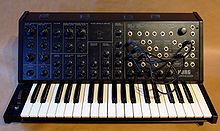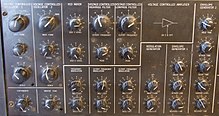Korg MS-20: Difference between revisions
| Line 68: | Line 68: | ||
==Musicians who have used the MS-20== |
==Musicians who have used the MS-20== |
||
The MS-20 has been used by bands and artists such as [[Astral_Projection_(group)|Astral Projection]], [[Deutsch-Amerikanische Freundschaft]], [[Cosmic Spring]], [[Felix Kubin]], [[Liaisons Dangereuses]], [[Soulwax]], [[Air (band)|Air]], [[A Flock of Seagulls]], [[Liam Howlett]] of [[The Prodigy]], [[MSTRKRFT]], [[Simian Mobile Disco]], [[Spleen United]], [[Daft Punk]], [[Digitalism]], [[Shapeshifter (band)|Shapeshifter]], [[William Orbit]], [[Electrosexual]], [[Simon Posford]], [[Skinny Puppy]], [[Greg Anderson]], [[Stephen O'Malley]], [[Randall Dunn]], [[Orchestral Manoeuvres in the Dark]], [[Eliot Lipp]], [[Chicks on Speed]], [[Scooter (band)|Scooter]], [[Severed Heads]], [[Safety Scissors]], [[Goldfrapp]], [[Dubstar]], [[Covenant (band)|Covenant]], [[The Faint]], [[Villa Rosa]], [[Mr. Oizo]], [[Kimouts]], Zia McCabe of [[The Dandy Warhols]], [[Foals]], [[Friendly Fires]], [[Klaxons]], [[Royksopp]], [[Legowelt]], [[The Presets]] and [[STIJN]] have also used an MS-20. [[Aphex Twin]] likes to put many of his sounds through the ESP (External Signal Processor), which is also used by Mira Aroyo of [[Ladytron]]. |
The MS-20 has been used by bands and artists such as [[Astral_Projection_(group)|Astral Projection]], [[Deutsch-Amerikanische Freundschaft]], [[Cosmic Spring]], [[Felix Kubin]], Elena Smith of [[The Fall (band)|The Fall]], [[Liaisons Dangereuses]], [[Soulwax]], [[Air (band)|Air]], [[A Flock of Seagulls]], [[Liam Howlett]] of [[The Prodigy]], [[MSTRKRFT]], [[Simian Mobile Disco]], [[Spleen United]], [[Daft Punk]], [[Digitalism]], [[Shapeshifter (band)|Shapeshifter]], [[William Orbit]], [[Electrosexual]], [[Simon Posford]], [[Skinny Puppy]], [[Greg Anderson]], [[Stephen O'Malley]], [[Randall Dunn]], [[Orchestral Manoeuvres in the Dark]], [[Eliot Lipp]], [[Chicks on Speed]], [[Scooter (band)|Scooter]], [[Severed Heads]], [[Safety Scissors]], [[Goldfrapp]], [[Dubstar]], [[Covenant (band)|Covenant]], [[The Faint]], [[Villa Rosa]], [[Mr. Oizo]], [[Kimouts]], Zia McCabe of [[The Dandy Warhols]], [[Foals]], [[Friendly Fires]], [[Klaxons]], [[Royksopp]], [[Legowelt]], [[The Presets]] and [[STIJN]] have also used an MS-20. [[Aphex Twin]] likes to put many of his sounds through the ESP (External Signal Processor), which is also used by Mira Aroyo of [[Ladytron]]. |
||
Nicole Skeltys of [[Biftek]] and Steve Law of [[Zen Paradox]] and others played in an MS-20 only [[improvisational]] group called the MS-20 Arkestra in [[Melbourne]] on 6/6/06. |
Nicole Skeltys of [[Biftek]] and Steve Law of [[Zen Paradox]] and others played in an MS-20 only [[improvisational]] group called the MS-20 Arkestra in [[Melbourne]] on 6/6/06. |
||
Revision as of 16:50, 13 June 2009
| MS-20 | |
|---|---|
 Korg MS-20 | |
| Manufacturer | Korg |
| Dates | 1978–1983 |
| Technical specifications | |
| Polyphony | Monophonic |
| Timbrality | Monotimbral |
| Oscillator | 2 VCOs per voice |
| LFO | 1 |
| Synthesis type | Analog subtractive |
| Filter | 2 high-pass/low-pass |
| Attenuator | 2 VCA 2 envelopes |
| Aftertouch expression | no |
| Velocity expression | no |
| Storage memory | none |
| Effects | none |
| Input/output | |
| Keyboard | 37 keys |
| External control | CV/Gate |
The Korg MS-20 is a patchable semi-modular monophonic synthesizer which Korg released in 1978 and was in production until 1983. It was part of Korg's MS series of instruments, which also included the single oscillator MS-10, the keyboardless MS-50 module, and the SQ-10 sequencer. Additional devices included the MS-01 Foot Controller, MS-02 Interface, MS-03 Signal Processor, MS-04 Modulation Pedal and VC-10 Vocoder.
Although the MS-20 follows a conventional subtractive synthesis architecture of oscillators/filter/vca, its patch panel allows some rerouting of both audio and modulation, and it includes an external signal processor. This flexibility led to its resurgence during the analog revival of the late 90's.
Audio path
Oscillators

The MS-20 has two VCOs. The output of VCO1 can be set to triangle, sawtooth or adjustable-width pulse. The output of VCO2 can be set to sawtooth, square, rectangle or "ring mod" which is in fact an exclusive-OR between the pulse output of VCO1 and the square wave output of VCO2. Although the pulse width of VCO1 is adjustable, there is no voltage control for this parameter and as a result pulse width modulation is not possible. The VCOs have Hz/V voltage control inputs.
Filters
There are two VCFs in series. The first is a 6 dB/oct [1] [2] high-pass, the second a 12 dB/oct low-pass. Resonance ("peak" in Korg parlance) is adjustable but not voltage-controlled.
Originally, the filters used Korg's proprietary KORG-35 chip. Later, the filters were redesigned to use off-the-shelf LM13600 OTAs. MS-20 fitted with LM13600 filters have a small daughter board.
Output
The final component in the audio path is a VCA. It is a single-transistor design, based on a selected 2SC945.
Modulation

Modulation generator
The MS-20 has a low frequency oscillator, labelled "modulation generator". It has two controls (rate and shape) and two outputs (pulse and sloped).
The shape control was a rather unusual feature for the time. It affects the duty cycle of the pulse output and the shape of the sloped output. When the control is at the anticlockwise end, the pulse width is very high (pulse output stays high for most of the cycle) and the sloped output is an upward sawtooth wave. At the clockwise end, the pulse width is very low (pulse output stays low for most of the cycle) and the sloped output is a downward sawtooth wave. At midway, the pulse width is 50% (pulse output is a square wave) and the sloped output is a triangle wave.
The pulse output is available through the patch panel. It is unipolar (0 or +5V) and suitable for triggering the S&H or the envelope generators.
The sloped output is bipolar (-2.5V to +2.5V). Like the pulse output, it is available through a dedicated jack on the patch panel. It also feeds the top modulation bus and so can be used to modulate the frequency of the VCOs and the cutoff frequency of either or both VCF without patching.
Envelopes
There are two envelope generators. EG1 has Delay, Attack, and Release parameters, whilst EG2 has Hold, Attack, Decay, Sustain and Release. The envelope generators have S-trig trigger inputs.
Other sources and options
The MS-20 also includes a noise source (pink and white), a separate vactrol-based modulation VCA, a wheel controller, and a trigger button. It is possible to connect the MS-20 to a step sequencer like the SQ-10 (another product by Korg). This involves making use of the CV input and the trigger input which connects straight to the SQ-10, this means that the synthesiser and the step sequencer can work in synchronisation to play the notes when the next step of the sequencers pattern is triggered. In theory it is possible to connect any analogue sequencer to the MS-20 providing it has a trigger and CV input.
External signal processor
The MS-20 includes a frequency-voltage converter, envelope follower and gate extractor which can be used to drive it with an external signal. By connecting the output of the F-V converter to the CV input of the VCOs (VCO 1+2 CV IN) and the output of the gate extractor to the trigger input of the envelope generators (TRIG IN), the operator can play the MS-20 through his/her voice or another instrument.
Instead of triggering the envelope generators, one can connect the output of the envelope follower to the main VCA's INITIAL GAIN input. In that mode of operation, the envelope generators are not used and the envelope of the MS-20's output is simply that of the external signal.
Software
There is a software emulator of the MS-20 included in the KORG legacy Collection.
Another MS-20 emulator called KORG DS-10 was released for the Nintendo DS in 2008.
Musicians who have used the MS-20
The MS-20 has been used by bands and artists such as Astral Projection, Deutsch-Amerikanische Freundschaft, Cosmic Spring, Felix Kubin, Elena Smith of The Fall, Liaisons Dangereuses, Soulwax, Air, A Flock of Seagulls, Liam Howlett of The Prodigy, MSTRKRFT, Simian Mobile Disco, Spleen United, Daft Punk, Digitalism, Shapeshifter, William Orbit, Electrosexual, Simon Posford, Skinny Puppy, Greg Anderson, Stephen O'Malley, Randall Dunn, Orchestral Manoeuvres in the Dark, Eliot Lipp, Chicks on Speed, Scooter, Severed Heads, Safety Scissors, Goldfrapp, Dubstar, Covenant, The Faint, Villa Rosa, Mr. Oizo, Kimouts, Zia McCabe of The Dandy Warhols, Foals, Friendly Fires, Klaxons, Royksopp, Legowelt, The Presets and STIJN have also used an MS-20. Aphex Twin likes to put many of his sounds through the ESP (External Signal Processor), which is also used by Mira Aroyo of Ladytron.
Nicole Skeltys of Biftek and Steve Law of Zen Paradox and others played in an MS-20 only improvisational group called the MS-20 Arkestra in Melbourne on 6/6/06.
